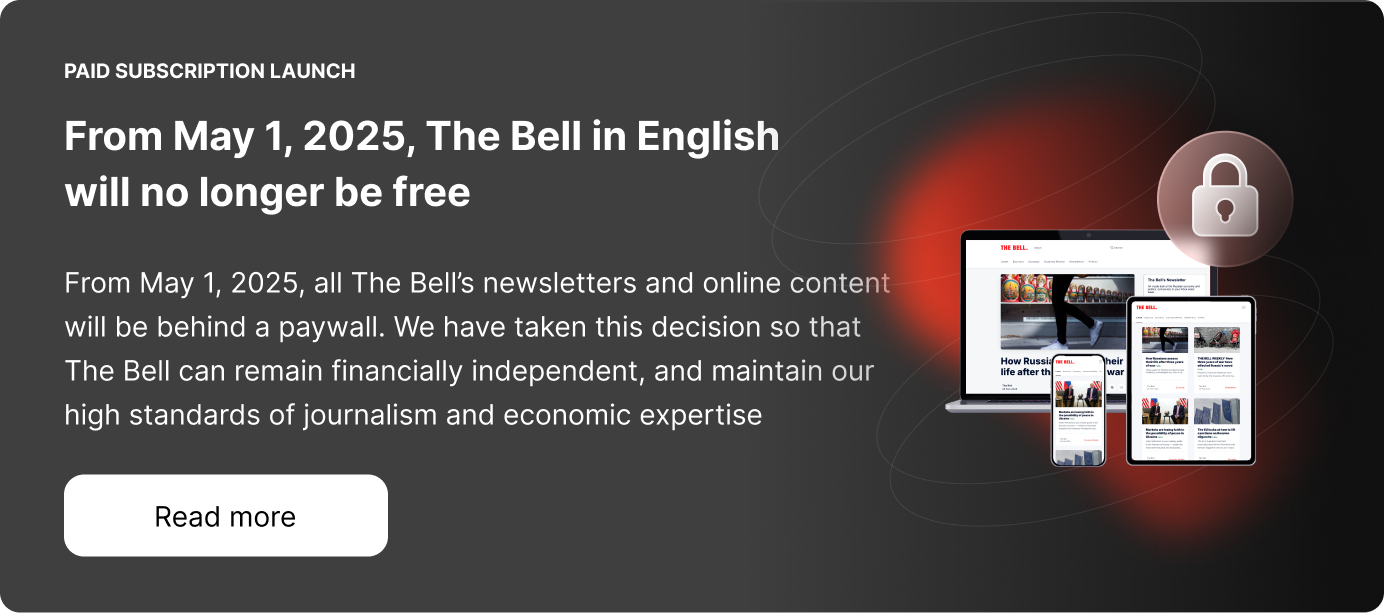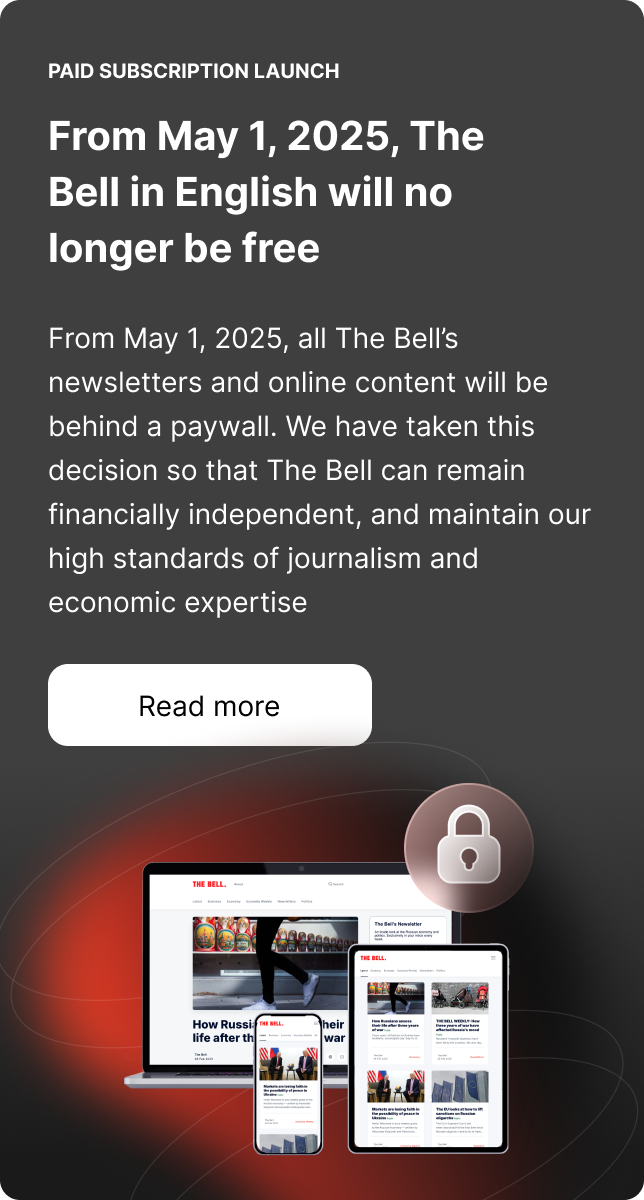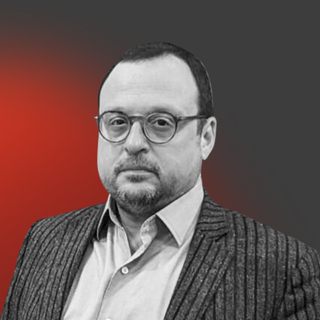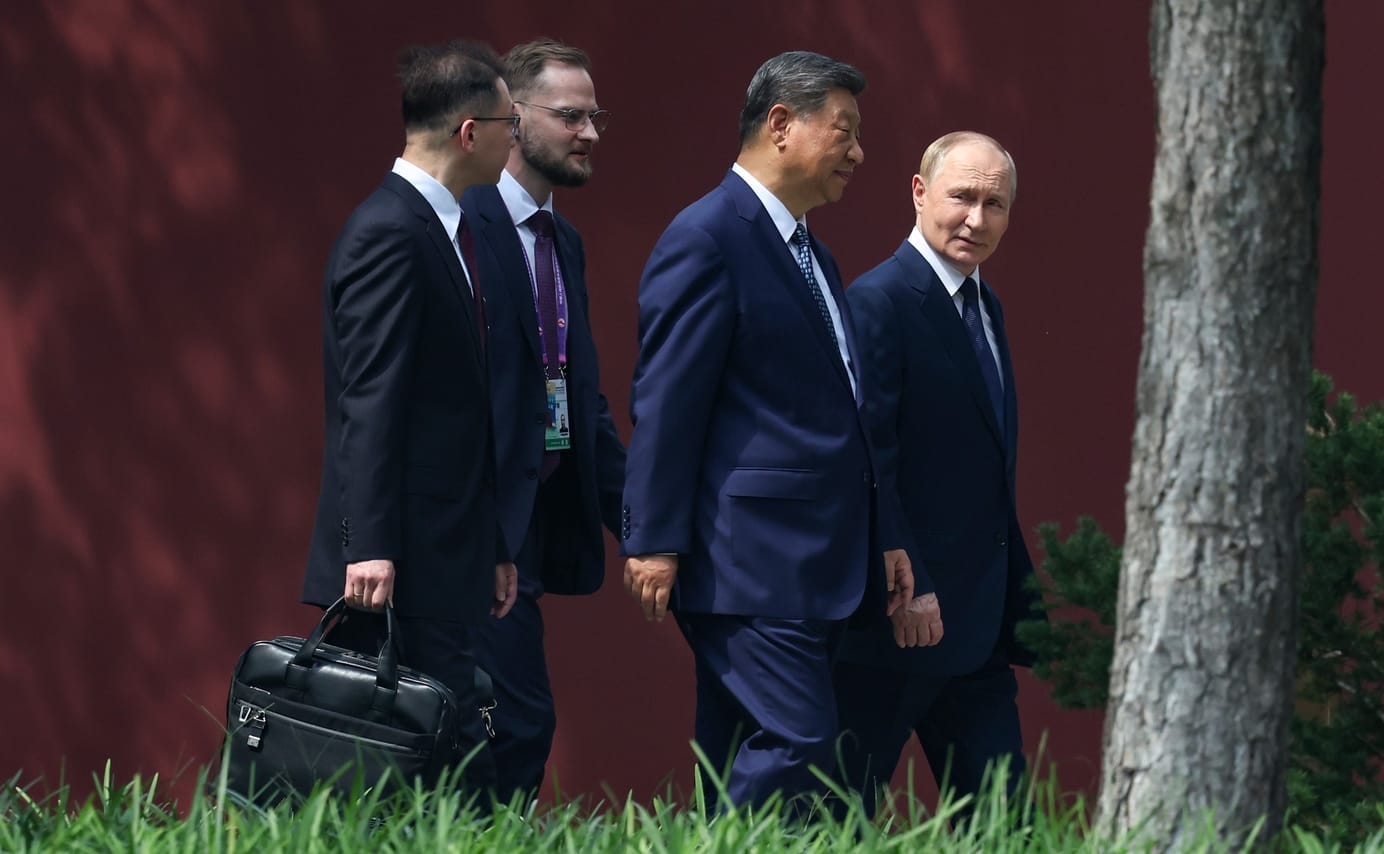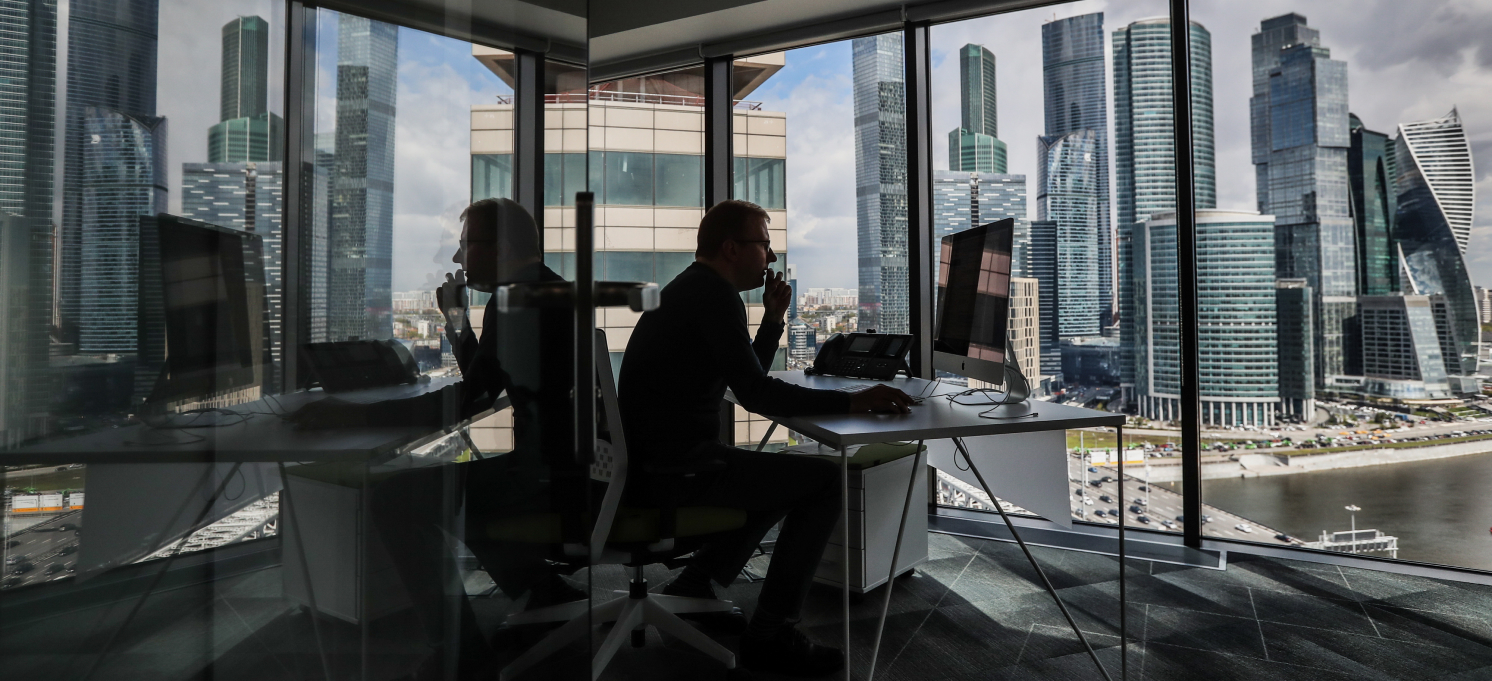
L'économie russe se refroidit
Bonjour ! Bienvenue dans votre guide hebdomadaire de l'économie russe, rédigé par Alexandra Prokopenko et Alexander Kolyandr et présenté par The Bell. Cette semaine, nous examinons le ralentissement de l'économie russe et les raisons pour lesquelles il ne cause pas de maux de tête à Vladimir Poutine. Nous abordons également les projets de Moscou visant à restreindre le programme d'importations parallèles, qui a fourni une abondance de biens de consommation malgré les sanctions.
Avant de commencer, un petit mot de l'un de vos rédacteurs, le cofondateur de The Bell ,Pyotr Mironenko:

Chers lecteurs,
Je m'occupe de nos bulletins d'information, que je rédige ou que j'édite, depuis les tout premiers jours de The Bell. Plus tôt dans la journée, j'ai parcouru ma boîte de réception à la recherche de notre toute première lettre d'information en anglais - C'est effrayant à dire, mais elle a été publiée il y a plus de sept ans.
Je n'aurais jamais imaginé que les histoires que nous avons écrites sur cette semaine de 2017 seraient encore d'actualité. Poutine briguait un nouveau mandat présidentiel, des officiers du FSB étaient jugés pour avoir divulgué des informations sur les tentatives russes de piratage de l'élection américaine, et le Kremlin essayait de découvrir ce que contiendrait le prochain train de sanctions de Washington. Nos brèves conclusions sur la signification de tout cela se sont avérées exactes. Nous avions déjà prévenu à l'époque que les sanctions ne feraient que forcer les oligarques russes à ramener leurs milliards de dollars en Russie. Après l'invasion russe de l'Ukraine en 2022, c'est exactement ce qui s'est passé.
Au cours des sept années qui se sont écoulées depuis la publication de cette lettre d'information, ce qui n'était au départ qu'une petite expérience s'est transformé en un projet d'envergure. Nous publions désormais deux bulletins d'information en anglais par semaine. Depuis 2023, nous publions chaque semaine une lettre d'information approfondie sur l'économie russe, dans laquelle nos auteurs habituels, les experts économiques Alexandra Prokopenko et Alexander Kolyandr , examinent en détail et en profondeur les principaux sujets de la semaine. Cette publication s'ajoute à notre première lettre d'information hebdomadaire dans laquelle nous expliquons la signification des événements majeurs de la politique, de la société et des affaires russes.
Le 1er mai, les bulletins d'information en anglais de The Bellpasseront derrière un paywall. Sans l'introduction d'abonnements payants, nous ne serions tout simplement pas en mesure de continuer à vous fournir cette analyse avec la même qualité, le même niveau de détail, la même rapidité et la même fréquence. Malheureusement, nous n'avons pas d'autre choix. Les subventions accordées aux médias comme le nôtre ont été fortement réduites et, de toute façon, nous avons toujours été réticents à dépendre d'un soutien à grande échelle.
Pour tout éditeur, demander aux gens de payer pour un contenu est toujours un moment émotionnel et difficile. Il est agréable que votre produit soit largement lu et utilisé gratuitement. Mais lorsque les gens sont prêts à payer, c'est la preuve qu'ils apprécient vraiment ce que vous leur apportez. Ce sentiment est l'un des principaux avantages de notre travail trépidant.
Je connais certains d'entre vous personnellement depuis des années, et j'ai appris à en connaître d'autres grâce à de longues conversations visant à déterminer ce que vous attendez de notre couverture. Pour cela, je vous remercie de nous avoir aidés à améliorer et à affiner nos bulletins d'information au cours des sept dernières années.
En tant que lecteur régulier, vous pouvez vous abonner à un tarif préférentiel grâce à notre réduction exclusive sur nos plans de pré-commande. Dépêchez-vous de profiter de notre réduction exclusive !
Cette offre expirera le 1er mai. Abonnez-vous et restez avec nous !
La croissance russe alimentée par la guerre s'essouffle
L'économie russe n'est plus en surchauffe. L'inflation et la croissance économique ralentissent et le marché du travail n'est pas aussi tendu que l'année dernière. La croissance qui subsiste dans l'économie russe est concentrée dans l'industrie manufacturière - en particulier le secteur de la défense et les industries connexes - et est alimentée par les dépenses de l'État. Mais pour Vladimir Poutine, qui est accaparé par l'offensive en Ukraine, la croissance n'est pas une fin en soi. Au moins sur le plan politique, un léger ralentissement ne posera pas de problème majeur.
Que se passe-t-il ?
La surchauffe de l'économie russe touche à sa fin. Les données de janvier et février, ainsi que les enquêtes de consommation de mars et avril, indiquent que l'activité économique est en expansion, mais à un rythme plus lent qu'au cours des trimestres précédents. Les économistes de la Banque centrale l'ont souligné dans leur dernier bulletin analytique analytique. La croissance pour le premier trimestre de l'année devrait être plus lente qu'au cours des trois derniers mois de 2024, lorsque Rosstat avait rapporté une expansion de 4,5 % en glissement annuel.
Plusieurs signes indiquent un ralentissement de l'économie russe :
- L'inflation corrigée des variations saisonnières (SAAR) s'est établie à 7,1 % en mars, tandis que la moyenne sur trois mois était de 8,3 %, contre 12,9 % au quatrième trimestre 2024. Il est vrai que le renforcement du rouble a eu un impact plus important que la baisse de la demande. Sans la hausse du rouble, l'inflation en mars et au premier trimestre aurait été plus proche de 10% SAAR, a calculé la Banque centrale. Mais il y a toujours un refroidissement visible de la demande dans certains secteurs du commerce de détail, principalement les biens de consommation durables.
- L'inflation hebdomadaire indique un ralentissement régulier. Au cours de la deuxième semaine d'avril, les prix ont augmenté de 0,11 %, ce qui porte l'inflation totale à 0,27 % pour le mois d'avril. Dans le même temps, nous avons assisté à la plus forte baisse hebdomadaire des indices de prix des biens non alimentaires au cours de l'année écoulée.
- La dynamique du crédit est en net recul par rapport aux niveaux observés au cours des trois premiers trimestres de 2024, en raison de la hausse des taux d'intérêt frappant les emprunts et du retrait prévu des avantages macroprudentiels pour les banques. Une partie du ralentissement peut également s'expliquer par les dépenses budgétaires traditionnellement élevées pour les paiements anticipés des contrats de l'État au début de l'année. Les analystes de la Banque centrale estiment que les bénéficiaires utilisent ces fonds budgétaires pour rembourser des prêts. En mars, le budget fédéral a terminé avec un solde positif de 530 milliards de roubles, tandis que le taux de croissance du portefeuille de prêts aux entreprises a grimpé de 0,1 % en février à 0,9 % en mars. La Banque centrale a expliqué ces chiffres par la nécessité pour les entreprises de payer des impôts à la fin du premier trimestre. L'accélération du crédit aux entreprises pourrait être un facteur pro-inflationniste.
- L'effondrement des marchés financiers mondiaux en mars et avril a eu pour effet de refroidir les investissements dans les actifs russes.
- Le rouble a gagné près de 20 % par rapport au dollar américain depuis le début de l'année. En mars, le taux moyen du dollar était de 86,1 roubles, tandis que le yuan chinois était à 11,8 (les taux de février étaient respectivement de 92,8 et 12,6). La force du rouble a été alimentée par le dégel des relations entre les États-Unis et la Russie, un dollar plus faible face à la guerre des tarifs douaniers, les ventes de devises du ministère des finances dans le cadre de la règle budgétaire et une baisse des importations.
- Au premier trimestre, l'utilisation des capacités de production a chuté dans l'ensemble de l'économie, passant de 81 % à 79 %, les baisses les plus importantes étant observées dans la construction, le commerce et la logistique.
- La demande a connu une brève poussée en janvier, mais en février-mars, la croissance des dépenses de consommation était déjà en baisse. Le ralentissement de la consommation a contribué à réduire l'inflation au premier trimestre. Les entreprises n'ont pas d'attentes élevées : les entreprises sont prudentes dans leurs estimations de la demande pour le reste de l'année. La préférence pour l'épargne demeure et les augmentations de salaires devraient se modérer, ce qui suggère que la demande augmentera encore en 2025, mais faiblement.
Ce que disent les chiffres
Au cours du dernier trimestre 2024 et du premier trimestre 2025, le principal soutien à la demande provenait de l'État par le biais de contrats et d'avances accrues. Aujourd'hui, les dépenses budgétaires se sont normalisées et leur influence est plus faible.
La dynamique de l'industrie indique également un refroidissement de l'économie. Après un bond de 8,2 % de la production en décembre 2024, lié à une forte augmentation des contrats d'État, la croissance de la production industrielle a ralenti à 2,2 % en janvier et 0,2 % en février (bien que le chiffre de février soit également un symptôme de l'effet de calendrier, 2024 étant une année bissextile).
Le ralentissement de la production est largement dû à la baisse des industries extractives, qui ont chuté de 4,9 % en février. Le secteur manufacturier a progressé de 3,2 %, plus de 60 % de cette croissance provenant de la construction de machines. Dans l'ensemble, l'industrie continue de stagner, selon les experts du Centre d'analyse et de prévision macroéconomique dans leur dernier rapport. dans leur dernier rapport.
Dans le secteur manufacturier, l'écart entre les industries liées au complexe militaro-industriel et celles qui ne le sont pas ne cesse de se creuser. L'augmentation du coût des pièces et des matières premières, le ralentissement de la demande intérieure et la pénurie de main-d'œuvre freinent toute augmentation de la production, selon une étude de la Banque centrale.
Les entreprises deviennent également plus prudentes. Au premier trimestre, l'activité d'investissement en Russie était nettement inférieure à ce qu'elle était à la fin de l'année 2024, selon la la Banque centrale. Les raisons en sont une incertitude accrue et un ralentissement général de l'activité commerciale. L'une des plus grandes entreprises métallurgiques de l'Extrême-Orient a déclaré qu'en raison de la baisse de la demande intérieure, elle devrait reporter une partie de son programme de modernisation.
Certaines entreprises ont expliqué la faiblesse des tendances en matière d'investissement en évoquant des niveaux anormalement élevés en 2024. Les commandes de défense de l'État et la substitution des importations restent les principaux moteurs de l'investissement. Dans l'enquête de la Banque centrale, une usine de construction de wagons dans le centre de la Russie a signalé une augmentation des investissements en raison de la demande supplémentaire de l'État, et une entreprise de construction navale dans le sud a parlé de la nécessité d'augmenter la capacité pour répondre au besoin croissant de navires civils.
Selon les prévisions officielles, la croissance économique devrait ralentir cette année, passant de 4,1 % à 2,5 %. À la fin de l'année dernière, Vladimir Poutine a indiqué qu'il ne s'agit pas d'une préoccupation majeure pour lui. "Aussi étrange que cela puisse paraître, compte tenu des réalités macroéconomiques actuelles, nous n'avons pas encore besoin de cette croissance", a-t-il déclaré.
Pourquoi le monde doit-il s'en préoccuper ?
Après trois années de militarisation de son économie, la Russie est confrontée à un ralentissement. Il s'agit pour l'instant d'un ralentissement en douceur, sans atterrissage brutal et avec une modération progressive du rythme de croissance. Mais il ne s'agit pas d'une transition vers une économie prospère en temps de paix. Le modèle économique russe n'est pas en train de se reconstruire, il est simplement en train de s'essouffler. Cet équilibre délicat pourrait être rapidement rompu. Par exemple, l'inflation pourrait repartir à la hausse si les dépenses publiques augmentaient ou si les prêts aux entreprises s'accéléraient. Des facteurs externes peuvent également jouer un rôle imprévisible, en particulier un ralentissement économique mondial dû à une guerre commerciale entre les États-Unis et la Chine.
La Russie s'attaque aux "importations parallèles
Pour soutenir les fabricants russes, les autorités russes se préparent à réduire considérablement les possibilités d'"importations parallèles", un processus par lequel les détaillants russes ont pu obtenir des produits occidentaux, tels que des iPhones et du Coca-Cola, alors même que les entreprises elles-mêmes ont cessé d'expédier directement en Russie. Izvestia a rapporté que le ministère du commerce et de l'industrie élabore actuellement une ordonnance visant à limiter les importations parallèles. À l'heure actuelle, des catégories entières de marchandises - en particulier des biens de consommation - peuvent être importées par le biais de ce système, mais les nouvelles règles resserreraient les catégories et n'autoriseraient que des marques spécifiques.
Que sont les "importations parallèles" ?
Ce système permet aux entreprises russes d'importer des produits étrangers sans obtenir l'autorisation du détenteur de la licence ou des droits. Il a été développé pour la première fois dans les dernières années de l'Union soviétique. Après la libéralisation du commerce extérieur, c'est ainsi que des flux importants de produits sont entrés dans le pays. En effet, n'importe qui pouvait acheter des marchandises à l'étranger et les importer dans le pays pour les revendre.
Progressivement, ce système non réglementé est devenu plus ordonné. Les producteurs étrangers ont commencé à vendre leurs produits en Russie par l'intermédiaire de partenaires agréés, ce qui a permis de réduire les prix et de lutter contre la contrebande et la contrefaçon. Lorsque les entreprises étrangères ont quitté massivement le marché russe en 2022, ce système de franchises sous licence, de partenaires locaux et de ventes directes a pris fin. Face à la possibilité d'être coupées de divers biens de consommation occidentaux, ce qui risquait de provoquer un mécontentement populaire et une flambée de l'inflation, les autorités russes se sont à nouveau tournées vers les importations parallèles. Le ministère du commerce met à jour chaque trimestre sa liste de produits et de marques pouvant être importés sans l'autorisation du détenteur des droits étrangers. Aujourd'hui, pour la première fois, il s'apprête à réduire considérablement cette liste.
Pourquoi maintenant ?
La principale raison pour laquelle la Russie vise ce régime est de protéger et de stimuler la production nationale, qui doit faire face à la concurrence des importations. Cet aspect est de plus en plus important à mesure que l'économie et la demande ralentissent. Une autre raison possible est de réduire les sorties de capitaux en diminuant le niveau global des importations. Cela pourrait s'avérer nécessaire pour soutenir la balance des paiements de la Russie si les prix du pétrole s'effondrent de manière prolongée et que le rouble s'affaiblit à nouveau. Dans ce cas, l'existence d'alternatives locales limiterait l'inflation. Une troisième raison pourrait être la volonté de civiliser le marché russe et de le rendre plus attrayant pour le retour éventuel d'entreprises étrangères.
Pourquoi le monde doit-il s'en préoccuper ?
La répression des importations parallèles est en grande partie une réponse au ralentissement économique et à la baisse de la demande. Mais à court terme, elle pourrait entraîner une nouvelle hausse de l'inflation. En raison des sanctions et de la guerre, les marques occidentales ne reviennent pas en Russie. Et même si l'économie se refroidit, elle reste confrontée à une pénurie de main-d'œuvre et de capacités.
Protégées de la concurrence par un rouble relativement fort et une consommation stable, les entreprises locales auront du mal à résister à la tentation d'augmenter les prix. Une situation similaire s'est produite en 2014, lorsque les prix ont augmenté après que la Russie a interdit les importations européennes. Ce sont à peu près les mêmes raisons pour lesquelles les économistes s'attendent à une hausse de l'inflation aux États-Unis à la suite de la guerre tarifaire du président Donald Trump. Dans le cas de la Russie, la barrière n'est pas un tarif, mais des interdictions bureaucratiques.
Chiffres de la semaine
Les attentes du public en matière d'inflation en avril ont grimpé à 13,1% contre 12,9% en mars, mais sont restées inférieures au niveau de 13,7% enregistré en février. Dans le même temps, les estimations des particuliers concernant le niveau actuel de l'inflation ont diminué, passant de 16,5 % à 15,8 %. Les attentes des entreprises et de la population en général en matière d'inflation font partie des facteurs clés que la Banque centrale prend en compte lorsqu'elle décide des taux d'intérêt. La prochaine réunion de fixation des taux est prévue pour le 25 avril.
La durée moyenne des prêts hypothécaires a considérablement augmenté. Selon la la Banque centrale, en février 2025, la durée moyenne des prêts hypothécaires a augmenté de cinq mois pour atteindre 209,8 mois, soit près de 26 ans. C'est l'un des niveaux les plus élevés jamais observés. L'augmentation des emprunts à long terme est liée à la hausse des prix de l'immobilier et aux taux d'intérêt élevés. Pour maintenir une mensualité supportable, les banques et les emprunteurs allongent la durée du prêt.
Entre le 8 et le 14 avril, l'inflation hebdomadaire a ralenti de 0,16% à 0,11%. L'inflation annuelle est passée de 10,28 % à 10,38 %. L'inflation des produits alimentaires est toujours alimentée par les fruits et légumes, tandis que les prix des produits non alimentaires diminuent, peut-être en raison d'une baisse de la demande.
Pour en savoir plus
La Russie que Poutine a faite. Moscou, l'Occident et la coexistence sans illusions
Où se trouve le camp pro-Trump de l'Ukraine ?
Lukashenko cherche à profiter du rapprochement entre les États-Unis et la Russie




